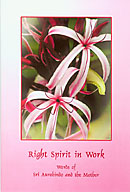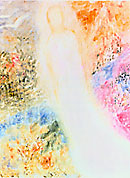
|
When Huta first exhibited the paintings she has now collected in her new book Pictures of Sri Aurobindo's Poems the Mother had written: "Those who appreciated the illustrations of Savitri will surely like to see these paintings." After the New Publications section, we offer a brief glimpse into the book and a look at a few of Huta's paintings inspired by lines from Sri Aurobindo's poems.
NEW PUBLICATIONS
To order any book, click on the title, which will locate the book in our online catalogue. Next, add it to the shopping cart. You may then proceed to pay by credit card online.
ENGLISH |
 | Pictures of Sri Aurobindo's Poems
— Paintings by Huta with verses from Sri Aurobindo's poems and relevant quotations from the Mother and Sri Aurobindo
ISBN: 978-81-87372-17-2
Publisher: The Havyavahana Trust, Pondicherry
Binding: Soft Cover
Pages: 118
Price: Rs 400
| In March 1967 Huta began the work of expressing some of Sri Aurobindo’s poems through paintings. Under the Mother’s inspiration and guidance she selected certain passages from the poems and completed fifty-four paintings, which were all shown to the Mother in September of that year. This new book presents these paintings along with the lines which inspired them from some of Sri Aurobindo’s most well-known poems, such as “Invitation”, “Who”, “Thought the Paraclete”, and “A God’s Labour”. Appropriate quotations from the Mother and Sri Aurobindo, some comments on the paintings by the Mother, and background information and photographs accompany the plates. The entire book is printed on art paper.
|
 | India and the Future of South Asia
— Kosha Shah
Publisher: Auroville Arts, Auroville
Binding: Soft Cover
Pages: 84
Price: Rs 100
| The author examines some of the fundamental issues which are of central importance to South Asian countries and in the context of efforts made so far in developing a regional identity. The aim is to find a new light with which to view the current conflicts and uncertainties, a light drawing inspiration from what Sri Aurobindo and the Mother have said on the future of the region. Using historical perspectives and illustrative passages from their works, she discusses how culture, civilisation, religion, spirituality, and secularism impact the development of national and regional identities. The final chapter offers an overview of both the problems and possibilities of a South Asian confederation, with the emphasis on India to lead the way towards a greater integration.
|
 | The Horizon (Diganta)
— Nishikanta
Publisher: Sri Aurobindo Sthan, Kolkata
Binding: Soft Cover
Pages: 71
Price: Rs 80
| Readers of Nirodbaran's Correspondence with Sri Aurobindo will be familiar with the many references there to Nishikanta's development as a poet in Bengali and in English. Sri Aurobindo once called him "a Brahmaputra of inspiration" and remarked that "he got a touch here which brought out in him some powerful force of vital vision and word". This English translation of Diganta, Nishikanta's book of seventy-three poems in Bengali, has been published to commemorate his birth centenary. Most of these poems deal with his inner experiences as a sadhak and a poet, but an appendix has been added to include "Integral India", written on August 15, 1947, and inspired by Sri Aurobindo's message on that occasion.
|
 | Right Spirit in Work
— Words of Sri Aurobindo and the Mother
ISBN: 978-81-7060-271-2
Publisher: Sri Aurobindo Society, Pondicherry
Binding: Soft Cover
Pages: 56
Price: Rs 15
|
|
 | What are we Seeking in Life and the Key for it
— Words of Sri Aurobindo and the Mother
ISBN: 978-81-7060-270-5
Publisher: Sri Aurobindo Society, Pondicherry
Binding: Soft Cover
Pages: 44
Price: Rs 15
|
|
GUJARATI |
 | Jyotirgamaya
Sri Aravind - Srimatajina Lakhanomathi Madhukari
— Words of Sri Aurobindo and the Mother
Publisher: Sri Auroma Trust, Ahmedabad
Binding: Hard Cover
Pages: 326
Price: Rs 60
|
|
|
Pictures of Sri Aurobindo's Poems
|
Following her exhibition of Savitri paintings in 1967, Huta felt strongly a need to express some of Sri Aurobindo’s poems and sonnets through the same medium. With the Mother’s blessings she began this work in March of the same year. On the first day the Mother read a passage from Songs to Myrtilla, made a sketch with a few strokes, and explained to her the colour scheme. The Mother was very happy with the painting that Huta rendered that night inspired from that sketch.
“Simply sit in front of the boards”, she told her with a luminous gaze, “and the inspiration will come,” and she caressed her hands. With these words in her heart and under the occasional direct guidance of the Mother, Huta completed 54 paintings by September 1967.
Huta’s book Pictures of Sri Aurobindo’s Poems is a collection of these paintings alongside Sri Aurobindo’s verses that inspired the pictures and some of the Mother’s comments.
In this book one sees how Huta intricately fills her canvas in her own style, embracing her forms with a force of vivid colours and bold textures in some paintings or subtle colours with soft strokes in others to express the nature of the poem. She explores with her brush strokes her own journey and experience of the poems, reflecting their individual voices and subjects.
Painting is an expression of the artist’s personal journey with the Divine. The viewer should try to see beyond the mere appreciation of the picture with the physical eye and feel or experience its subtle vibration and the consciousness that was put into it as demonstrated in some of the examples that follow.
|

Click to enlarge |
The Dream Boat
Who was it that came to me in a boat made of dream-fire,
With his flame brow and his sun-gold body?
Melted was the silence into a sweet secret murmur,
“Do you come now? is the heart’s fire ready?”
|
|
In the painting for “The Dream Boat” Huta illustrates a boat of fire with a representation of a divine being as a boy standing on this boat. An aura of light surrounds his head and he basks in soft golden light. The sea has a serene movement and merges with the hues of the sky. Gently-introduced pink tones indicate the sweet secret murmur.
|

Click to enlarge |
Beyond the Silence
One with the Eternal, live in his infinity,
Drowned in the Absolute, found in the Godhead,
Swan of the supreme and spaceless ether wandering
winged through the universe,
Spirit immortal.
|
|
For “Beyond the Silence”, Huta depicts a swan soaring upwards as a symbol of the individual soul turning towards the Divine. She lifts the paint in its wings to create feathers and infuses dream-like soft colours for the spaceless ether, bringing a quietude to the canvas.
|
|
Adwaita
I walked on the high-wayed Seat of Solomon
Where Shankaracharya’s tiny temple stands
Facing Infinity from Time’s edge, alone
On the bare ridge ending earth’s vain romance.
|

Click to enlarge |
|
A lofty mountain strikes the eye with its bold colours in the painting inspired by “Adwaita”, and in its rendering the upward strokes of the brush carry the eye to the top where one discovers a temple in white. The subtle blue hues of the sky create a sacred atmosphere around the temple.
|
|
Divine Sight
A master-work of colour and design,
A mighty sweetness borne on grandeur’s wings;
A burdened wonder of significant line
Reveals itself in even commonest things.
|

Click to enlarge |
|
A divine being almost ethereal is shown in the painting for “Divine Sight”. A suggestion of fields, a river, birds, and a mountain peak in the background, rendered in light-filled, happy tones, create an atmosphere of delight and wonder.
In Huta’s paintings one feels a concentration of consciousness that permeates the canvas and a meditative energy flowing out from her work. In this rare book Huta shares with us her exquisite journey with the Mother through her soulful paintings on Sri Aurobindo’s poems.
|
Gopika |
|